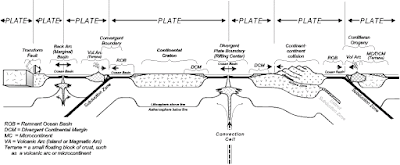Assembling California
Blog
PLATE BOUNDARIES
San Andreas Fault
Tomales Bay
transform boundary
“Tomales Bay lies about 50 kilometers (30 miles) northwest of San Francisco, along with the edges of two tectonic plates that are grinding past each other. The boundary between them is the San Andreas Fault, the famous rift that partitions California for hundreds of miles. To the west of the Bay is the Pacific plate; to the east is the North American plate. The rock on the western shore of the Bay is granite, an igneous rock that formed underground when molten material slowly cooled over time. On the opposite shore, the land is a mix of several types of marine sedimentary rocks. In Assembling California, John McPhee calls that side “a boneyard of exotica,” a mixture of rock of ‘such widespread provenance that it is quite literally a collection from the entire Pacific basin, or even half of the surface of the planet.'”
The edges of two tectonic plates - Tomales Bay
Monday, September 11, 2017
 |
| Plate tectonics |
Plate tectonics is the theory that the outer rigid layer of the earth (the lithosphere) is divided into a couple of dozen "plates" that move around across the earth's surface relative to each other, like slabs of ice on a lake.
Simplistically, the earth consists of the plates, and plate boundaries, those zones where the plates contact and interact. Observe that 7 different plates are labeled in the cross section. Plates are combinations of two units, continents and ocean basins. A plate may be an ocean basin alone, or a continent alone, or a combination of ocean basin+continent (common).
It is possible a plate could be a continent alone, but for this to occur all edges of the continent would have to be a plate boundary (very rare, perhaps not practically possible). Note that in the cross section several different ocean basin/continent combinations are present, but that it is difficult to get a continent with all plate boundaries.
➽ PLATE BOUNDARIES
The three kinds of plate boundaries are also illustrated in the cross section, divergent, convergent, and transform. Plate interact at these boundaries.
Two divergent margins (plate boundaries) are present in the cross section, one labeled as such to the right of the continental craton, and the other on the left side. The left side divergent margin is labeled Back Arc (Marginal) Basin. Back arc basins are formed by minor convection cells above subduction zones. Divergent plate boundaries always create new ocean floor (that is, new oceanic lithosphere, called the ophiolite suite).
Three convergent boundaries are present, all of them one way or another involving a subduction zone.
Only one transform boundary is present, on the left side of the drawing. Now we know about different following topics.
 |
| fig- source |
➽ The edges of two tectonic plates
LIKE OUR FACEBOOK PAGE- GEOGRAPHY (CLICK HERE)
Previous article
Next article
